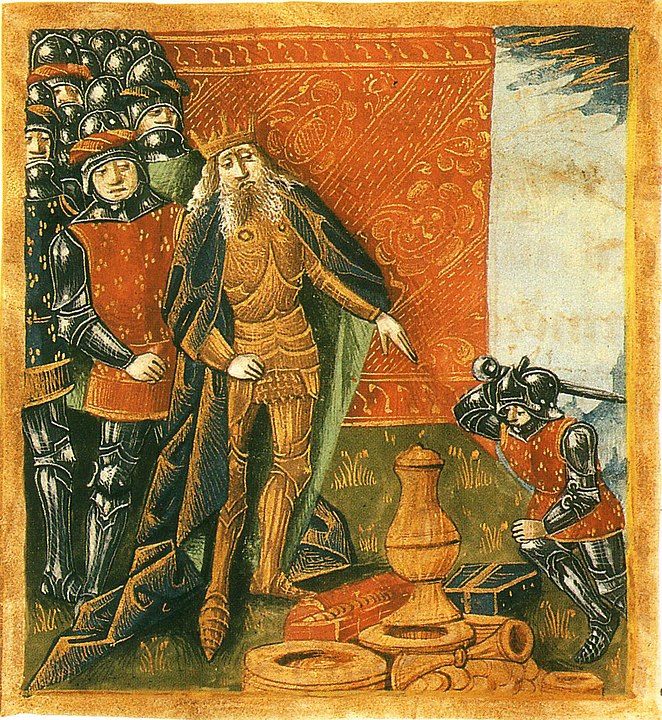In 481 AD, Clovis inherited the kingdom of his father, Childeric I. After unifying the Frankish peoples, the Merovingian monarch launched into the conquest of Gaul. In 486, he defeated the Gallo-Roman leader, Syagrius, at the Battle of Soissons. Following their victory, the Franks plundered the churches in the region and took away many valuable objects. Shortly after, the bishop of Reims asked Clovis to return a vase. The latter agreed, thereby transgressing Frankish traditions. One of his men challenged him by striking the vessel, but the monarch swallowed his anger.
A year later, Clovis recognized the warrior and shattered his skull with his Francisca (a favored short war axe of the Franks). He then uttered these famous words: “Just as you did to the vase of Soissons!” These words have stood the test of time and notably echoed under the Third Republic. Nearly a century after Gregory of Tours first reported it, the story of the Soissons vase continues to generate discussion. However, it carries strong symbolism: the connection between the Catholic Church and Clovis, who asserted his authority over the Frankish chiefs.
Note
The Vase of Soissons is significant in Frankish history as it is part of the legendary narrative surrounding Clovis I’s rise to power and his conversion to Christianity. The story illustrates aspects of Clovis’s character and leadership, as well as his relationship with his soldiers.
What Was the Historical Context of the Vase of Soissons?

In 476 AD, the Western Roman Empire vanished, yielding a patchwork of barbarian kingdoms. Around 481, upon his father’s demise, Clovis assumed leadership of the Salian Franks. Having consolidated his authority, he initiated the conquest of Gaul. In 486, scarcely 20 years old, the Frankish king vanquished the Gallo-Roman leader Syagrius in the Battle of Soissons. This event marked the demise of the final remnants of Roman authority in Gaul.
The account of the Soissons vase comes to us from Gregory of Tours, who, a century later, chronicled it in his work, “The History of the Franks.” The bishop and historian situate this incident in 486, directly following the Battle of Soissons. Clovis subsequently selected the captured city as the new stronghold of his realm. Following their triumph over the Roman army, the Frankish forces pillaged the religious edifices within Syagrius’s territory, seizing numerous precious artifacts and liturgical decorations, including a splendid vase of unparalleled beauty.
What Is the History of the Vase of Soissons?
After the plundering, the Bishop of Reims, Saint Remi, requests that Clovis return the liturgical vessel to him. Eager to please Saint Remi, the young Frankish king, as documented by Gregory of Tours, accedes to his request. Confronted with the gathered booty, Clovis seeks permission from his warriors to retrieve the object for its return to the bishop. This action deviates from Frankish custom, which typically mandates the distribution of wealth through drawing lots.
Nonetheless, his men willingly acquiesced to their monarch’s request. Only one warrior dissents, striking the vessel with his Francisca, a prized short war axe of the Franks. Clovis tolerates the insult and surrenders the dented vase to Saint Remi.
A year later, while inspecting his troops during the March field, Clovis identifies the dissenting warrior. Intent on retribution for the earlier challenge, he chastises the warrior for his negligent appearance. Subsequently, Clovis confiscates the warrior’s weapons and hurls them to the ground. The Frankish soldier stoops to retrieve them, at which point Clovis fatally strikes him with a blow from his Francisca, splitting his skull.
Why Do We Say “Remember the Vase of Soissons”?
At the Champ de Mars, Clovis delivers what could be considered a funeral oration for the warrior: “Just as you did to the vase of Soissons!” These words of the Merovingian king have remained famous throughout history, especially during the 19th and 20th centuries. During the Third Republic, school textbooks reported the most famous formulation: “Remember the vase of Soissons!” At that time, the national narrative, the story that valorizes the construction of the nation, becomes of great importance. Clovis, the first Frankish king converted to Christianity and grandson of the legendary Merovech occupies a central place.
It was during his reign that the borders of the Frankish kingdom were extended to most of Gaul. He is also credited with choosing Paris as the capital, and his victories are commemorated, notably at the Battle of Tolbiac. Baptized on December 25, between 496 and 511, he is honored as the founder of the Christian monarchy. Finally, the anecdote of the vase of Soissons, the first act of his reign, is remembered.
Did the Event of the Vase of Soissons Really Happen?
The episode of the Vase of Soissons remains a subject of debate among historians today. It is very difficult to separate fact from fiction due to the lack of detailed information about the Merovingian era. The writings of Gregory of Tours, who was not contemporary with Clovis, are the only source from this period. Therefore, it is impossible to confirm with absolute certainty the events the bishop described in the “History of the Franks,” written a century later.
They could have been distorted or twisted to serve the author’s ideas and used for political purposes. Nevertheless, the story of the vase of Soissons has a strong symbolic significance. Clovis departs from Frankish customs, centralizes power, and asserts his superiority over his warriors. He also demonstrates, through delayed violence, that one does not flout the king’s authority with impunity.
By returning the liturgical vase to Remigius, Clovis shows his respect for the bishops and aligns himself with the Catholic Church. With his baptism in Reims, he definitively rejects his pagan beliefs and ensures the support of the Gallo-Roman elites!






